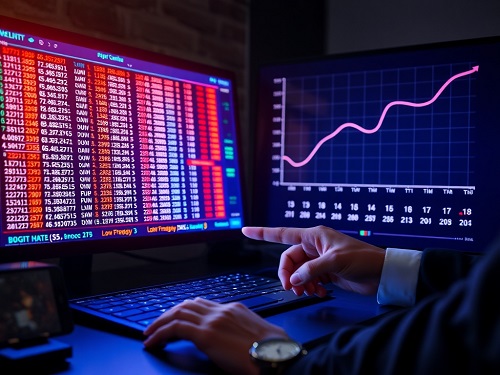What if the key to unlocking consistent profits in day trading isn’t a secret indicator, but a rigorous, data-driven testing process? The journey to a reliable online day trading system begins not in the live markets, but in the past. Day trading backtesting duration is the cornerstone of this journey, a critical step that separates hopeful amateurs from strategic professionals. It’s the process of simulating your trading strategy on historical data to see how it would have performed. But how much data is enough? The answer isn’t a simple number. It’s a nuanced decision based on your strategy, your mindset, and the ever-changing market landscape. This guide will demystify the process, providing a clear framework to backtest your way to confidence and competence.
Let’s dive into the factors that dictate the ideal backtesting period for your specific approach.

Trade Frequency and Day Trading Backtesting Duration: The Engine of Statistical Significance
The single most important factor in determining your day trading backtesting duration is how often your system generates signals. Think of it as a simple rule of statistics: the larger your sample size, the more reliable your conclusions.
- High-Frequency Systems: If your system generates 5-10 trades per day, you accumulate a robust dataset quickly. A backtest covering 6 to 12 months might yield over 1,000 trades. This is often sufficient to identify clear performance trends, equity curve behavior, and potential weaknesses. The high number of data points provides a strong foundation for statistical validation.
- Low-Frequency Systems: Conversely, a strategy that only signals 2-3 trades per month requires a much longer timeline to be meaningful. A mere one-year backtest might only show 30 trades—far too few to trust. For these systems, a backtesting period of 3 to 5 years, or even longer, is essential. This extended timeframe ensures you capture enough trades to validate the strategy’s edge across different environments.
In essence, your goal is to gather hundreds of trades, not just dozens. Let the trade frequency of your system guide your starting point.
The Asset’s Lifecycle and Your Day Trading Backtesting Duration: Why Context Matters More Than Age
A common mistake is backtesting a strategy on data that doesn’t reflect the current market’s structure. The nature of the underlying asset is paramount. For instance, backtesting a strategy for a cryptocurrency that launched in 2023 on data from 2020 is impossible and irrelevant. The same logic applies to more established instruments.
Consider the E-mini S&P 500 futures contract. While it launched in 1997, its liquidity and electronic trading characteristics were vastly different before 2002. A backtest using 1998 data may be technically possible, but it has little practical value for today’s market dynamics. The market’s “personality” has evolved.
Your backtesting strategies must account for this. The relevant day trading backtesting duration starts from when the asset began trading with characteristics similar to today—namely, sufficient liquidity and electronic access. Always prioritize data relevance over sheer data age.

Determining Day Trading Backtesting Duration by Conquering the Market’s Mood Swings
Markets are not static. They breathe, trend, crash, and stagnate. A strategy that excels in a roaring bull market might hemorrhage capital in a volatile crash or a quiet sideways grind. Therefore, your day trading backtesting duration must be long enough to encompass a variety of market conditions.
A one-year test might accidentally capture only a strong trending market. This creates a dangerous bias. You might develop immense confidence in a system that is ill-prepared for a different environment. A robust backtest should include:
- Bull Markets (Rising Prices)
- Bear Markets (Falling Prices)
- Sideways/Choppy Markets (Low Volatility)
- High-Volatility Events (e.g., like the 2020 COVID crash or the 2022 inflation-driven volatility)
Aim for a period that includes at least one significant shift in market regime. For example, a test from 2021 to 2024 would capture the late bull market, the 2022 bear market, and a period of recovery and uncertainty. This is far more valuable than four years of a steady bull market. This approach is fundamental to trading system optimization.
The Trader’s Mind: Backtesting as Psychological Armor
This is the most overlooked benefit. Backtesting is not just a technical exercise; it’s a psychological boot camp. By manually reviewing or observing hundreds of trades, you inoculate yourself against the fear and greed that doom live traders.
This process allows you to intimately witness every drawdown and navigate the emotional challenge of a strategy’s worst periods, including consecutive losses. By doing so, you build a powerful ’emotional memory.’ When your live account inevitably enters a losing streak, you can recall—with data-backed confidence—that the system has recovered from similar situations before. This cultivated resilience in trading psychology is priceless, effectively turning potential panic into disciplined patience.
A Practical Blueprint for Your Day Trading Backtesting Duration
So, what’s the magic number? Based on the factors above, here is a practical framework:
- Set a Minimum Trade Count: Aim for a minimum of 200-300 simulated trades. For high-frequency strategies, this may take months. For low-frequency ones, it may take years.
- Cover Major Market Phases: Ensure your selected period includes at least one distinct bull and bear phase. In today’s context, including data from 2022 (bear market) is highly recommended.
- Prioritize Relevant Data: Start your test from when the asset’s trading environment became modern and liquid. Don’t use archaic data for a modern strategy.
- A General Guideline: For most day traders, a day trading backtesting duration of 2 to 3 years is an excellent starting point. It typically provides enough trades and a sufficient variety of market conditions to be statistically and psychologically valuable.

Beyond the Basics: Optimizing Your Backtesting Process
To make your backtest truly reflective of reality, you must go beyond perfect-world assumptions. This is where trading system optimization meets real-world friction.
- Account for Costs: Include realistic commissions and slippage. In day trading, where profit margins can be small, transaction costs are a major factor. Assuming perfect fills will create a dangerously optimistic backtest.
- Use Robust Software: Platforms like TradingView, Sierra Chart, or MetaTrader offer powerful backtesting tools. Ensure they allow you to model order execution accurately.
- Avoid Over-Fitting: This is the cardinal sin of backtesting. Don’t endlessly tweak parameters to perfectly fit past data. You’ll create a “curve-fitted” system that fails miserably in the future. The goal is a robust system, not a perfect historical fit.
Your Path to Profitable Execution
You now have the blueprint. The question is no longer “how long,” but “how well.” A thorough backtest transforms trading from a game of chance into a profession of probabilities. It builds a foundation of knowledge that shields you from doubt and emotional decision-making.
Remember, you can absolutely succeed in this field. It demands discipline, patience, and a commitment to the process. The market rewards those who do their homework. By dedicating time to a comprehensive day trading backtesting duration, you are not just testing a strategy—you are building the confidence needed to execute it flawlessly when real money is on the line.
Start today. Define your strategy, gather your data, and begin the most important phase of your trading career: the preparation. Your future self will thank you for the diligence. The path to financial independence is paved with well-tested plans.


